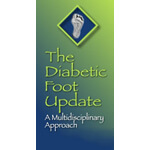 The 21st Annual “Diabetic Foot Update: A Multidisciplinary Approach” will be held Dec. 4-6 at the Westin Riverwalk Hotel. Designed for health care professionals who have a role in the management of diabetic foot pathology, this year’s conference will include an all-star lineup of national and international faculty renowned for their published work on neuropathy (nerve damage) and Charcot arthropathy (disease of a joint)– the topics on which this year’s conference will focus.
The 21st Annual “Diabetic Foot Update: A Multidisciplinary Approach” will be held Dec. 4-6 at the Westin Riverwalk Hotel. Designed for health care professionals who have a role in the management of diabetic foot pathology, this year’s conference will include an all-star lineup of national and international faculty renowned for their published work on neuropathy (nerve damage) and Charcot arthropathy (disease of a joint)– the topics on which this year’s conference will focus.
Diabetic neuropathy is the number one cause of Charcot arthropathy in industrialized countries. Charcot foot almost always occurs in diabetics with neuropathy. The joints of the arch collapse and, due to impaired sensation to pain, the individual may not notice the problem and will continue to walk on it. This can lead to severe deformities of the foot.
“Charcot arthropathy has become a major problem,” said Lawrence B. Harkless, D.P.M., Louis Bogy Professor of Podiatric Medicine and Surgery and a course director of this year’s seminar. “As of now, we know very little about it; but we’re bringing scientists from around the world to this conference that have an increased knowledge of the Charcot foot. These investigators have more recently have been studying the disease at the cell level.”
Patients with Charcot arthropathy present swelling, cellulitis and pain of the foot, mimicking infection. “The foot becomes red and swollen and is often mistakenly treated with antibiotics,” Dr. Harkless said. “Our question is ‘what is causing this disease at the cellular level?’”
Until 1988, the typical treatment for the Charcot foot was amputation. But, Dr. Harkless said new methods of treatment can skirt amputation. “We learned that by decreasing the temperature of the Charcot foot to that of an average foot we can screen treatment effects of the disease,” Dr. Harkless said. “Once the temperature stabilizes, we can manipulate the bones to compress joints, therefore treating the disease.”
But, what is the long term outcome? Dr. Harkless said that discovering ways of researching this will play a main role of this year’s Diabetic Foot Update.
Presenting the 2nd Annual Paul Brand Memorial Lecture will be the Health Science Center’s well-known writer and internist Abraham Verghese, M.D., D.Sc., (Hon.). Richard C. Adam, D.P.M., clinical professor in the podiatry division, and V. Kathleen Satterfield, D.P.M., associate professor in the podiatry division, are also directors of this year’s seminar.
Dr. Verghese is the Marvin Forland, M.D., Distinguished Professor of Medical Ethics and director of the Center for Medical Humanities and Ethics. He also holds the Joaquin G. Cigarroa Jr., M.D., Distinguished Chair in Medicine. The Paul Brand Memorial Lecture is an annual event at the conference, honoring Dr. Brand. One of the last lectures given by Dr. Brand before his death in August 2003, was at the 2002 Diabetic Foot Update sponsored by the Health Science Center.
The final day of the seminar will examine new studies, medications and other methods of the treatment of diabetes.
To view the brochure, click on: www.uthscsa.edu/HSCNews/archive/DiabeticFoot.pdf.

